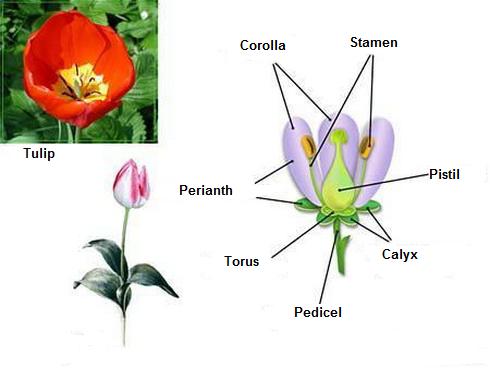|

Flowers and their parts function to achieve sexual reproduction, including pollination and seed formation. After pollination is finished, the flower begins the process of seed and finally fruit formation. During pollination, pollen grains are released from the anther and carried to the stigma, either by animals (such as insects, birds, and bats) or by wind. Animals, attracted by the flower's colors or aromas, visit flowers to obtain food either the pollen itself or the nectar, a sugary liquid produced by small glands called nectaries at the base of the flower. The animal brushes up against the anthers, which deposit pollen on the animal's body. The animal transfers the pollen to the stigma of either the same flower (self-pollination) or a second flower (cross-pollination). During wind pollination, the anthers release their pollen, which is then borne by air currents. Some of the grains are deposited on a stigma of the same or another flower.
Each pollen grain germinates and produces a slender thread of protoplasm that grows downward through the style and into the ovary. This thread, the pollen tube, contains the sperm and grows toward an ovule, where it deposits its sperm. The sperm then fuses with the egg, achieving fertilization as the first cell of the new generation is produced. The ovule matures to form a seed. At the same time, the surrounding ovary enlarges greatly, becoming a fruit as other parts of the flower recede and die off.
Because the stamens and pistils are intimately involved in reproduction, botanists refer to these as essential parts. The sepals and petals are termed nonessential parts, though in fact they remain important. The sepals and petals are sometimes called the perianthbecause they are found on the periphery of the anthers. A complete floweris one that has all four sets of parts. A perfect floweris one that has both androecium and gynoecium and is thus bisexual.
See also: Types of flowers, Structural Variations
|
